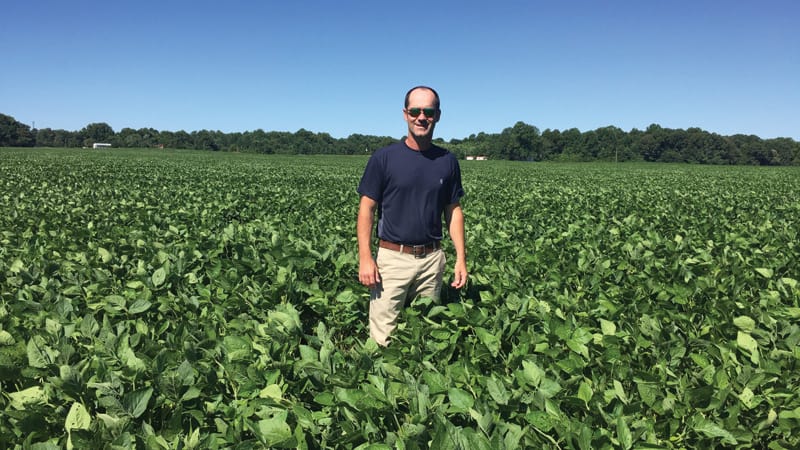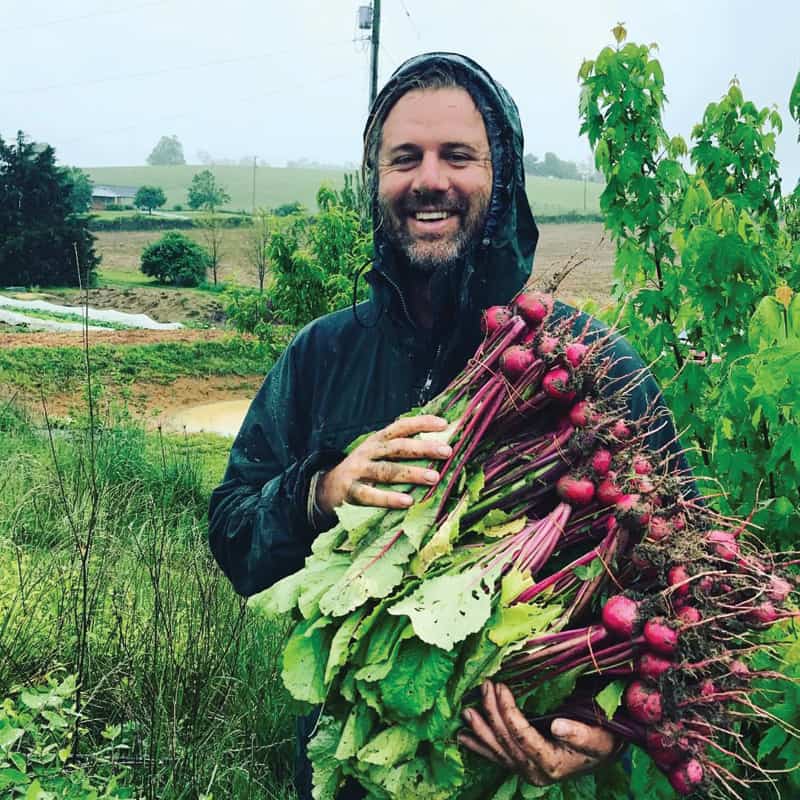Growing a Farm
Virginians tackling the challenges

It’s July 2015, and 38-year-old organic vegetable farmer Ryan Blosser has jolted awake: lightning tears open the darkness; thunder booms; windowpanes rattle; rain pounds down. He leaps out of bed and rushes to the front door. A flash confirms it: The wind is tearing the brand-new 30-by-100-foot hoop house from its anchors.
A big man of 6-foot-2, 220 pounds, Blosser crashes through the muddy yard like a blitzing linebacker. Flinging himself against the bucking aluminum frame, for the next 20 minutes, he battles the storm.
“That hoop house was my livelihood … to lose it would’ve been catastrophic,” he says. Blosser had recently resigned as the director of the farming nonprofit, Project Grows, to start his own operation, Dancing Star Farms. Winning a grant from the Natural Resources Conservation Service, he’d installed the $5,000 hoop house in the spring. Inside was $10,000 worth of maturing heirloom tomatoes he planned to sell at the Staunton Farmers’ Market – roughly one-third of the startup’s expected gross sales. “I was like Ahab battling the white whale: If the storm wanted to kill my dream, it was going to have to take me, too.”
The tempest passed.
“As a primary occupation, farming isn’t for the faint of heart,” Blosser says.
While rarely as extreme, such do-or-die-moments are par for the course for farmers. But usually the challenges are more protracted: drought, flooding, insects, mold, market changes, economic forces and other uncontrollable factors. Rising to the occasion, some Virginia farmers have maintained their operations for decades, while newcomers have capitalized on 21st-century trends.
FROM WATERMELONS TO MODERN MARKETS
According to the Virginia Department of Agriculture and Consumer Services, agriculture is Virginia’s largest private industry, with an economic impact of $70 billion annually, providing more than 334,000 jobs, each of which supports 1.7 jobs elsewhere in Virginia’s economy. Of Virginia’s farms – more than 44,000 of them – nearly 90 percent are owned and operated by individuals or families.
Only 4,921 farms in the Commonwealth reported more than $50,000 in sales in 2012, says Elaine Lidholm, Virginia Department of Agriculture and Consumer Services spokesperson. “The majority of our farmers are doing so part-time or are retirement farmers.”
“To make a family farming business work, you have to be really savvy,” says 43-year-old fourth-generation farmer Jay Taliaferro. Ten years ago, Taliaferro left a career in engineering to help manage the family’s grain farm in Essex County. He joined his cousin, Tom; his father, David; and two of David’s brothers. Jay says that beyond the daily elbow grease, the key to success is diligently “watching the markets” and “being willing to diversify” or even “totally change directions.”
In more than 72 years of business, the Taliaferros have shifted their focus numerous times. “My great-grandfather was a farmer, as was my grandfather and my father,” says Jay. Originally, the business focused on selling pickled watermelon rinds up and down the East Coast. Montague Farms was formed in 1976, when Jay’s father and three uncles incorporated the family holdings. At that point, the brothers “chose to focus on large-scale grain production,” namely, corn, barley, wheat and soybeans, “and things grew from there.”
In the early days, scaling up required taking out loans to buy land and better equipment.
According to Jay, if a commercial grain farmer wants “to compete with the big boys,” he has “to have a lot of land.” Seeking to centralize operations, the natural solution “was to buy acreage close to home and transform it into working fields.” However, that meant long backbreaking hours clearing forests, tearing out stumps, grading hills with a bulldozer, and, finally, tilling new fields. But the hard work paid off: within a decade, the Taliaferros were producing grains on more than 4,000 acres.
Tom says Montague was established by “selling [feed] to cattle and poultry farmers … mostly in the Shenandoah Valley and on the Eastern Shore.” Business grew until the mid-1980s, when the bottom fell out of the grain markets. A sharp drop in prices left many farmers scrambling to pay their bills. Compounded by a bad drought, the situation became unmanageable.
“A lot of [family farmers] had taken out loans on their land to try and weather the downturn,” says Tom, 43. A former financial consultant, he now serves as Montague’s business manager. Faced with a second crisis, many farmers defaulted on their loans, “and the banks were forced to foreclose.”
Feeling the crunch, the Taliaferros looked to new markets. They quickly added specialty products like high-moisture corn, wheat and barley to sell as animal feed. But if they wanted to do more than survive, they needed something else.
“My dad and uncles were very active in the farming community and served as officers in both the Virginia Grain Producers Association and the Virginia Agribusiness Council,” says Tom. Shaking the grapevine, the brothers learned of a new niche opportunity – growing non-GMO, food-quality soybeans for Japanese restaurants.
“Back then, the major producers were preparing to shift toward Roundup-ready crops,” says Jay. Resistant to pesticides, the genetically modified plants would be easier and cheaper to grow. But high-end Japanese restaurants wanted nothing to do with the stuff. Spotting a potential opening, the Virginia Cooperative Extension conducted studies that suggested the beans were well adapted to the Tidewater’s soil. Though “the market for these specialty varieties wasn’t lucrative enough to attract the big boys,” for an operation like Montague? “It was a match made in heaven.”
The brothers exported their first crop of soybeans in 1987. Within three years, they’d established a research partnership with Virginia Tech to develop non-GMO varieties to meet customer needs.
Montague has since expanded operations, selling to Korea, Malaysia, Vietnam, Thailand and Taiwan, exporting soybeans customized for “natto, tofu, sprouts, soy sauce” and more. To meet demand, the Taliaferros built two state-of-the-art, semi-automated cleaning and packaging facilities with a storage capacity of 20 megatons. Jay says Montague employs about 25 people and, in addition to its own lands, contracts with dozens of farmers in North Carolina, Virginia and Delaware to grow 10,000 to 15,000 additional acres of soybeans each year.
“My grandmother liked to say it was funny that my great-grandfather had expanded the business all the way to New York City, and now here we were shipping food across two oceans,” Jay says. “For them to make it, they had to go to New York. For us, it was to Japan and points beyond.”

A 21st-CENTURY TREND
In the past 20 years, the trend of sourcing foods locally has inspired other farmers to focus their attention closer to home.
The first nationwide USDA survey of local food marketing practices was conducted in 2015 to measure direct sales from farmer to consumers and other local customers. Lidholm of VDACS says the survey revealed that “3,415 Virginia farms sold about $220 million worth of food products directly to consumers, retailers and businesses that market regionally branded products.” The total constituted about 15 percent of the nation’s direct local farm sales, making Virginia the ninth largest direct-to-market producer in the U.S. In terms of farmers markets alone, there has been a jump from “88 in 2006 to more than 250 today,” Lidholm adds. “This is a major trend, and we’re very excited about it.”
At the same time, it’s hard for a family farm to get up and running. “They face tremendous hurdles,” says Leonard Githinji, a specialist with Virginia State University’s Small Farm Outreach program. In the early 20th century, many of Virginia’s full-time farmers had started as homesteaders who subsequently specialized and ramped up operations. Today, would-be full-time family farmers “are often trying to switch careers,” and thus “working long hours to get educated, then trying to scale up and enter the market as a viable full-time business” – and all with little to no startup money. “There is no margin for error. A bad crop early on will likely result in complete failure.”
This makes it tougher than ever to make the leap.
“Even if a full-time family farmer manages to survive into the years, he or she will have to stay abreast of changing agricultural trends and adapt to meet market demands,” says Githinji. Because of this, “Most don’t last for more than five years.”
Ryan Blosser is among this new wave of farmers. Since the storm, Dancing Star has grown by leaps and bounds. Selling through a consumer-supported agriculture program and at farmers markets, Blosser’s product line now includes 22 varieties of heirloom tomatoes, 10 varieties of eggplants, 14 varieties of peppers, a dozen types of lettuce, as well as flowers, herbs, quail eggs and rabbit meat. After hiring a full-time operator and two part-time seasonal helpers, Blosser expects to produce more than 40,000 pounds of vegetables this summer, which will sell for upward of $80,000. He projects gross sales will rise to $120,000 by 2020.
For Blosser, additions like rabbits, eggs and hoop-house crops offer insurance against unexpected reductions in yield due to “drought or too much rain.” Meanwhile, consumer demand for boutique craft beverages has led him to plant rare heirloom apple trees and invest in a small-batch cidery operation.
After all, as any successful farmer could agree: if life gives you apples, make cider.
Eric J. Wallace is a career journalist and avid outdoorsman. His writing has appeared in more than 40 magazines, including Backpacker, All About Beer, Canoe & Kayak, and Modern Farmer.


